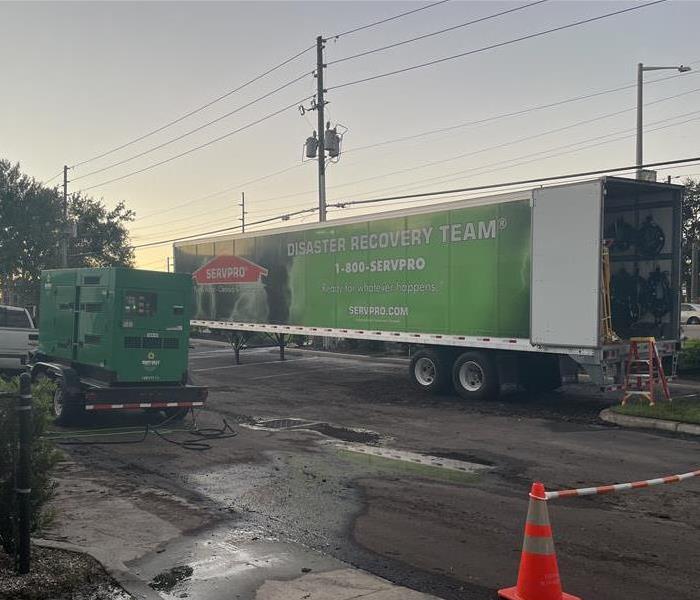Understanding Hurricanes
11/28/2022 (Permalink)
 SERVPRO of Parma/Seven Hills helping to restore a flooded building following Hurricane Ian in Florida.
SERVPRO of Parma/Seven Hills helping to restore a flooded building following Hurricane Ian in Florida.
You might be thinking, "I live in the Parma/Seven Hills area of Ohio, why do I need to know anything about hurricanes?" We completely understand this question. Hurricanes may not be an immediate threat to our homes and businesses in Ohio, but it is a good idea to stay informed on them as they may cause heavy rainfall in our area, they may affect you on a vacation, or your friends or family along the cost may be affected. Gaining knowledge on hurricanes can help keep you informed for the future.
At SERVPRO of Parma/Seven Hills, we have the opportunity to help when hurricanes hit anywhere along the coast. As a Disaster Recovery Team, we are able to mobilize our crews and equipment to help those affected by hurricanes, while still managing a crew at home to handle any water damage you may suffer locally.
Understanding Hurricanes
The strongest winds in a hurricane are generally found in the right side of the hurricane’s eye wall, the area closest to the center.
Once a hurricane makes landfall, wind speed will begin to decrease, and within 12 hours will have slowed significantly. However, winds can remain at hurricane strength well inland.
Hurricanes can also spawn tornadoes, which can increase destruction. These tornadoes generally occur in the right front quadrant of the storm, and in thunderstorms embedded in the hurricane, but not immediately near the center.
Not all hurricanes produce tornadoes, while some develop multiple tornadoes. According to the National Hurricane Center, “studies have shown that more than half of the land-falling hurricanes produce at least one tornado."
How Are Hurricanes Named? One reason hurricanes are named is because more than one may exist at the same time. Names make it easier to keep track of and talk about storms.
A storm is given a name if it reaches tropical storm strength. That name stays with the storm if it goes on to become a hurricane.
Each year, tropical storms are named in alphabetical order as they occur. The names come from lists of names that are maintained and updated by the World Meteorological Organization.
There are six lists of names. Each year starts with the next list. The same lists are reused every six years. Names of storms that are very deadly or costly are removed from the lists and replaced with new names.
What Are the Parts of a Hurricane?
- Eye: The eye is the "hole" at the center of the storm. Winds are light and skies are only partly cloudy, sometimes even clear, in this area.
- Eye wall: The eye wall is a ring of thunderstorms swirling around the eye. The wall is where winds are strongest and rain is heaviest.
- Rain bands: Spiral bands of clouds, rain and thunderstorms extend out from a hurricane's eye wall. These bands stretch for hundreds of miles and sometimes contain tornadoes.
Preparing Your Home
- Hurricane winds can cause trees and branches to fall, so before hurricane season trim or remove damaged trees and limbs to keep you and your property safe.
- Secure loose rain gutters and downspouts and clear any clogged areas or debris to prevent water damage to your property.
- Reduce property damage by retrofitting to secure and reinforce the roof, windows and doors, including the garage doors.
- Purchase a portable generator or install a generator for use during power outages. Remember to keep generators and other alternate power/heat sources outside, at least 20 feet away from windows and doors and protected from moisture; and NEVER try to power the house wiring by plugging a generator into a wall outlet.
- Consider building a FEMA safe room or ICC 500 storm shelter designed for protection from high-winds and in locations above flooding levels.
After a Hurricane
- Listen to local officials for updates and instructions.
- Check-in with family and friends by texting or using social media.
- Return home only when authorities indicate it is safe.
- Watch out for debris and downed power lines.
- Avoid walking or driving through flood waters. Just 6 inches of moving water can knock you down, and one foot of fast-moving water can sweep your vehicle away.
- Avoid flood water as it may be electrically charged from underground or downed power lines and may hide dangerous debris or places where the ground is washed away.
- Photograph the damage to your property in order to assist in filing an insurance claim.
- Do what you can to prevent further damage to your property, (e.g., putting a tarp on a damaged roof), as insurance may not cover additional damage that occurs after the storm.
Although you may not be directly affected by the next hurricane, this information can help you better understand the storm, and prepare you for the future.
If you experience local water damage from heavy rainfall, be sure to call the pros at SERVPRO of Parma/Seven Hills.

 24/7 Emergency Service
24/7 Emergency Service